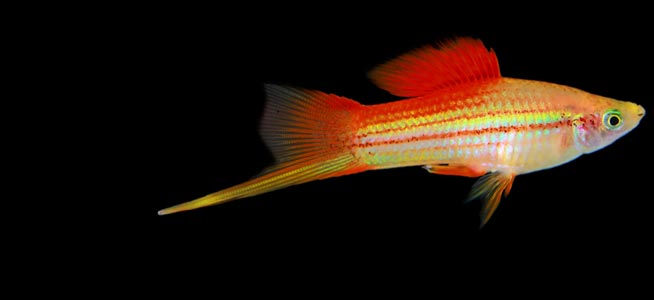Once you purchase an aquarium, you find yourself in a world of options. There are literally thousands of fish and plants and decorations to fill your freshwater tank. However, finding the best freshwater aquarium fish combination can be a challenge for both new and experienced fish keepers. You might not know which fish are temperamental or which ones get territorial.
Ideally, the best freshwater aquarium fish combination is one with peaceful fish that fill every level of the tank—top, middle, and bottom. Many fish will happily coexist as long as they have space and enough food. By doing some research, you can quickly come up with several combinations that will brighten up your tank.
That is why we have come up with a list of fish to help you find the perfect combination for your aquarium. Let’s get started.
Aquarium Basics

If you are a beginner aquarist, it is easy to overlook some key factors regarding stocking and tank mates and other things. It’s not uncommon to get carried away when choosing your fish or plants; think about these things carefully. Otherwise, you might wind up shopping for a whole new set up before too long.
Take your time and plan out everything. List out everything you need to make your tank successful, including the type of plants you want, lighting, substrate, and what the best freshwater aquarium fish combinations would be for your tank. If you have a small budget, then you should wait a little to make sure you get a decent aquarium.
Also, if you plan on having more than one kind of fish—which is why you’re here—then you cannot get a micro tank. Smaller tanks are not easier to manage. In fact, smaller tanks get dirtier more quickly and require consistent clean up. Water temperature is also bound to fluctuate, affecting your fish.
That is why, if you want to keep several fish, start out with a 20 gallon tank (or bigger), get the appropriate heating, filter, light, substrate, and everything else you need. Then, whatever fish combinations you choose, you will be successful.
Aquarium Levels and Schooling Fish

Source: The Spruce
There are two main points that many people overlook when stocking their aquarium: swimming levels and schooling. If you want a harmonious tank, then you should choose fish that like to swim at different water levels within the tank. Not only does this promote a more balanced aquarium, but it gives your fish more room to move around and remain peaceful. In other words, you can help reduce territorial stress.
There are three swim levels: top, middle, and bottom. Some fish—danios, upside down catfish, and rosy barbs—will swim at any level.
Top level fish are top feeders and will hang out around the surface of the aquarium. They are also strong at jumping and will be able to leap out of the aquarium, so you will need to cover your tank. Popular top dwellers include halfbeaks and hatchetfish. Some tetras, gouramis, rainbowfish, swordtails, and guppies will also move from top to middle.
Schooling fish are middle-level. They are small, fast-moving, and prone to nipping at bigger fish, which is why you should avoid combining small middle level swimmers with larger, slower fish, like barbs and angelfish or betta fish. This is a poor combination. Furthermore, if you do choose schooling fish, you will need to have enough of the same species for schooling to work (typically 5-6 fish in a school), which may decrease the number of species in the talk altogether.
Lastly, the bottom-dwellers. These are the fish who rarely leave the substrate and will quest along the bottom of the tank for food and debris. Some bottom swimmers are nocturnal and need to be feed at night. They are usually placid.
The Best Freshwater Aquarium Fish Combination
These fish are best for those who are new to fishkeeping. In general, they are hearty and friendly, so they won’t become too territorial about their space. So, without further ado, here are the best freshwater aquarium fish combinations:
Platies

The humble platy is kind of like a guppy in both appearance and coloring, but many fishkeepers believe that platies are even lower maintenance than guppies. You can find orange, blue, white, yellow, and red platies. Males are smaller than their female counterparts and are best kept in a group, with the generally stocking rule being 2 females for every single male.
Platies need live plants and decorations to hide, even if they have plenty of other fish to form a school. The minimum size tank for platies is 20 gallons. Keep the water between 65-78 degrees F (18-25 degrees C).
You can pair platies with tetras, guppies, mollies, and many other fish on this list without any issues.
Guppies
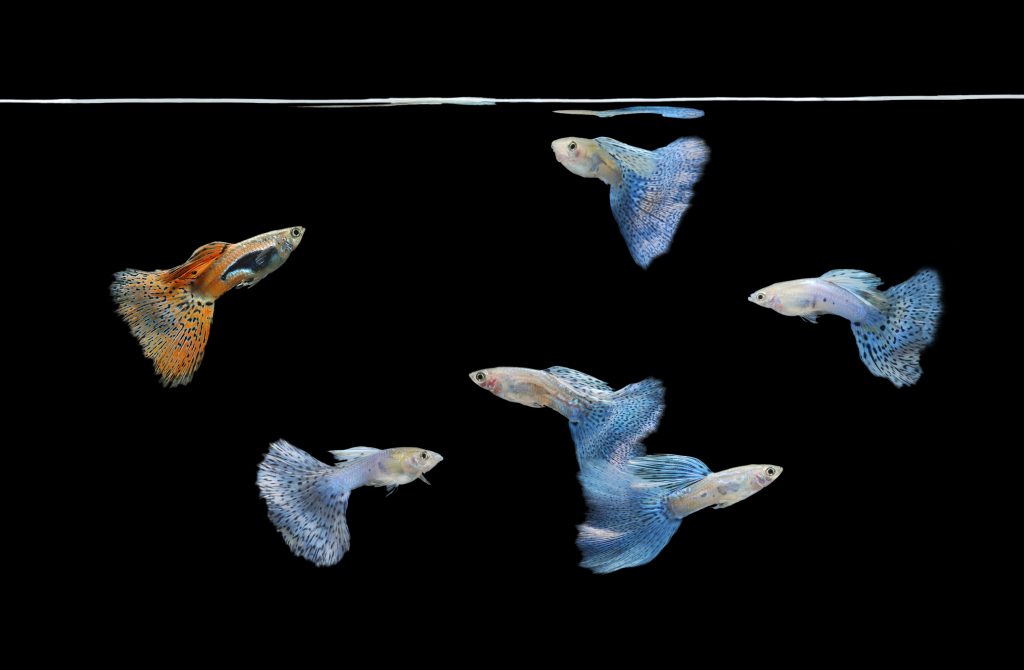
Wherever you go to buy fish, you are bound to find guppies. They are extremely popular and come in hundreds of colors. Since guppies are adaptable and hardy, you can keep them in a number of environments. You don’t even require much equipment. The minimal tank size for guppies is 10 gallons, but since they are best kept in a group, you should opt for a larger water volume.
Males are smaller than females, but both sexes are peaceful in a mixed tank. They prefer a temperature between 78-82 degrees F (25-27 degrees C) and a pH level between 6.8-7.8.
Tetras

There are several kinds of tetras, but most of the fish require the same tank set up and care. Tetras are best kept in a school tank of at least 5-6 fish rather than a community one, but they are also very docile and pair well with danio and guppies, among others. A favorite is the neon tetra with their bright red and blue striping.
Some tetras are large, like the cardinal tetra, which looks like a bigger neon tetra, but most prefer the same parameters: live plants, low lighting, and softer water. They are omnivorous, so give them a varied diet.
Cherry Barbs

Source: Aquatic Arts
These bright red fish come from the tropical waters of Sri Lanka. They are small, reaching about 2 inches (4 cm) maximum, and can live up to 4 years. If you want to add these fish to your tank, you should keep in mind that any barb fish is going to become aggressive during mating season. Therefore, you should keep only females or only males to curb this behavior.
They don’t require much light and prefer to school among plants. A 25-30 gallon is considered the minimum. Ideal tank mates for cherry barbs include loaches, catfish, white cloud mountain minnows, tetra, platies, mollies, and gouramis.
Mollies

Source: Pet Guide
Here is another visually appealing and docile fish for your tank. Mollies come in a number of shapes and sizes, but most of the time they are black and have either short fins or sail fins. Short finned mollies are typically easier to keep and much more common. Sail finned mollies require a bit more effort to keep healthy, making them a better choice for experienced aquarists.
Mollies can grow up to 4 inches (10 cm) and live around 2-3 years. These fish are very passive when they have plenty of room, with 20 gallons being the minimum. If you want to breed the fish, it is recommended to have 3 females to 1 male (a group of 4), but you can always just keep one gender without issues.
Another popular choice for aquariums is the swordtail, a freshwater fish that looks something like a goldfish but does not grow as large. There are many colors available, including gold, red velvet, or even Koi tricolor. These fish are very active and have a unique sword-shaped tail. Males grow to about 3.14 inches (8 cm) in length, with their tail measuring about 2 inches (5 cm). Females are bigger, reaching about 4.72 inches (12 cm).
One warning: Males can become aggressive with one another, especially during breeding season. Swordtails will also eat their own young, so if you do plan on breeding your fish, you will have to remove the babies quickly once they are born.
Pearl Gourami
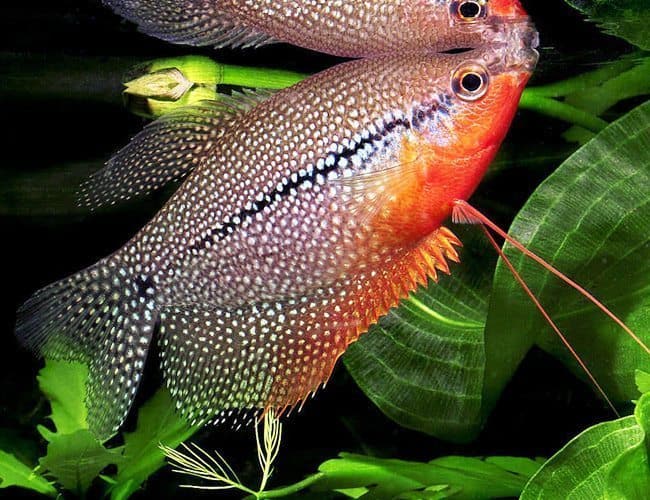
Source: Azgardens
Beautiful fish are often difficult, but not the pearl gourami, a vibrantly colored tropical fish. These gourami are named for the pearlescent quality of their bodies. You may also hear them referred to as “lace gourami.” They are bubble nest builders, much like betta fish, and they need plenty of fresh air. Avoid too many obstructive plants on the surface of the aquarium.
Pearl gourami can be kept in a small group or with tank mates that are just as peaceful as they are. Since they can be timid at times, they may get picked on (literally) but more aggressive fish.
You can keep your pearl gouramis shimmering and healthy by giving them plenty of algae-based foods, as well as live and freeze-dried morsels.
Corydoras Catfish

Source: Aquatic Arts
Fun fact: Corydoras catfish are just one of the over two thousand species of catfish. However, they are also one of the best freshwater aquarium fish for use in a community tank, because they mind their own business. Many hobbyists love the peaceful, almost oblivious, personality of these tiny catfish.
Generally, the corydoras grows to about 2.5 inches (6 cm) and have a lifespan of 3-5 years if the conditions of the tank remain around 72-79 degrees F (22-26 degrees C) with a pH of 6-8. The minimum size is 10 gallons, and you can keep them in groups of 6 or more in larger tanks.
Kuhli Loach

As a bottom level dweller, loaches are a unique addition to any tank, because they look more like an eel than a fish. They come in a wide array of colors and patterns, and they are known to display interesting behaviors as they scour the substrate for their next meal. Since they stay small (5 inches/10 cm max) you don’t have to worry much about maintenance. Just make sure they are getting enough food!
The minimum tank size for the kuhli loach is 20 gallons. You will have to quarantine your loach first, since they can be negatively affected by sudden changes in water. They are also most active at night.
You can keep loaches for up to 10 years in small groups (usually 3-4 fish). Make sure that their tank mates are not much larger, since loaches can fall prey to more aggressive and larger fish.
Zebra Danio
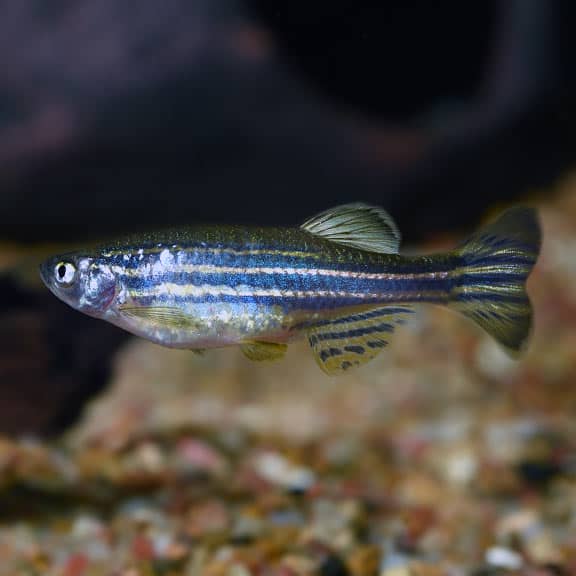
Source: Live Aquaria
We can’t forget the popular zebra danio in our list of the best freshwater aquarium fish combinations. These fish look like little aquatic zebras with silvery yellow and black scales and narrow bodies. They can grow up to 2 inches (5 cm), prefer a pH level of 6.5-8.0, and thrive in temperatures between 65-75 degrees F (18-24 degrees C).
Danio are considered peaceful, but if they are stressed, they will nip at fins. You should keep them in schools of 6 or more fish to bring out their best qualities. Ideal tank mates include other types of danio, tetras, and corydoras. They swim around the top and middle levels, so give them plenty of space to dart around.
Intermediate and Elite Freshwater Fish For Your Tank
Next, we have some fish you can add to your tank if you are seasoned and know how to deal with various types of fish and their behaviors.
Hatchetfish

Freshwater hatchetfish are different from deep sea hatchetfish, but they have the same eye-catching shape and ray fins. Native to South America and Panama, these upper level fish spend most of their time just below the surface, searching for food. While hatchetfish are usually very peaceful, they are classified as intermediate difficulty because they have a tendency to leap out of the fish tank when alarmed. In fact, thanks to the enlarged pectoral muscles, these fish can lift themselves out of the water and almost fly across the surface.
They are bound to make for an interesting addition to your tank—as long as you keep a lid on it. Common hatchetfish are best kept in a small school of 5-6 fish and need about 10 gallons of water minimum.
Killifish

Source: AquariumFish
Over 1,000 species of this fish exist throughout the world, and their shapes and colors widely vary. Most killifish, however, are quick swimmers, brightly colored, and love to leap from water. This means you are going to need a secure lid for your fish tank. Since male killifish are known to become slightly aggressive with other male fish, these are often an ideal choice for intermediate or experienced aquarists with at least a 20 gallon tank. Otherwise, killifish are easy to care for.
You can find Golden Wonder killifish in many pet stores. Exercise caution when pairing these common killifish with smaller tank mates. It has a mouth that is as large as its head, so it will eat anything that fits into its maw. The best freshwater aquarium fish combination for killifish is other killifish, as well as celestial pearl danios, smaller varieties of catfish, guppies, tetra (if you have smaller killifish), and other peaceful fish.
Glassfish
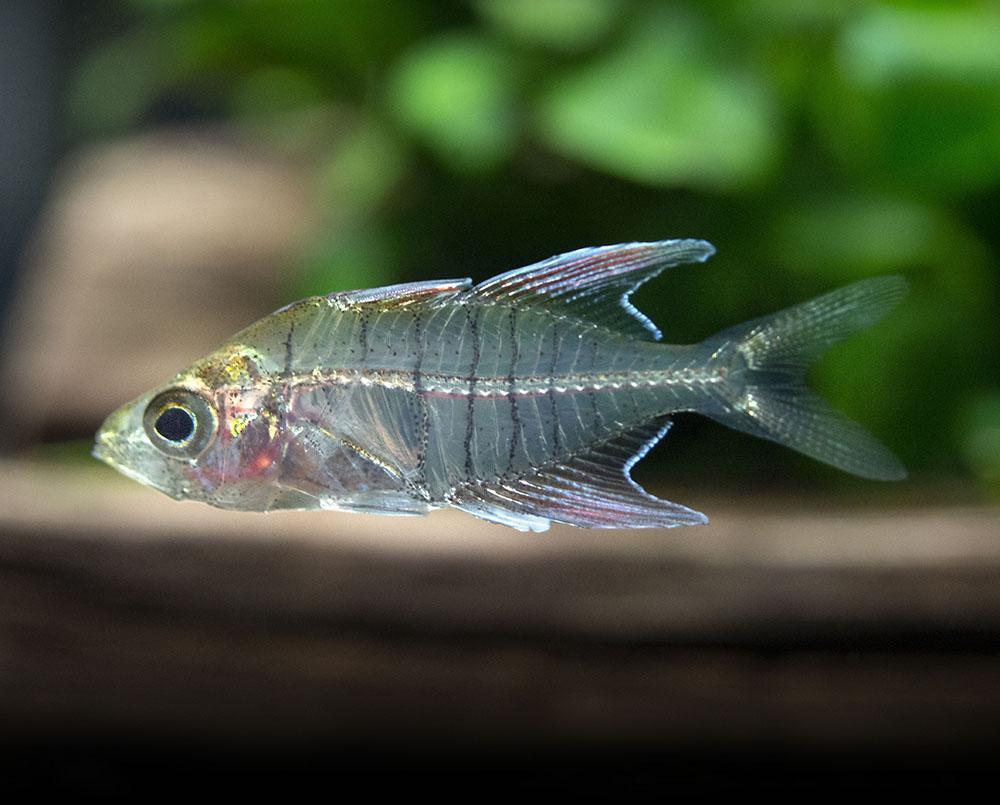
Source: Aquatic Arts
Here are fish that look like they come straight out of a Tim Burton film. Glassfish are considered exotic. You can see through their transparent scales to the bones beneath, as well as some organs. Unfortunately, many glassfish are sold with artificial dyes injected into their bodies. Avoid buying them, because they are prone to sickness, infection, and premature death.
Glassfish are native to South Asia, grow up to 3 inches (7.62 cm) in length, and prefer warmer, slightly acidic water. They prefer to be in schools of 5 or more glassfish, but they will also live peacefully with their tank mates, such as platies, mollies, tetra, and guppies. You shouldn’t buy fish larger than a full grown glassfish, however, because they may get eaten. The minimum tank size is 20 gallons.
Tiger Plecos

Source: Live Aquaria
Plecos are another kind of catfish that are often considered great fish for community tanks. They are usually beginner-friendly, but they can grow quite large, too, making them more difficult to care for. If you have an aquarium that tends to breed algae, these fish do a wonderful job at buffing the walls. Tiger plecos got their name from their patterning, which looks like a tiger’s stripes. The entire body is covered in white (or orange) and black.
They are introverted fish that like a more tranquil setting, and they rarely depart from the bottom of the tank. While they can survive without plants, you do you adequate substrate and a few hiding spots to keep them happy. The water temperature needs to be warmer, around 80-82 degrees F (26-27 degrees C), and the water requires a bit of acidity—around 6.0-7.0 pH. 40 gallons is the minimum tank size.
Conclusion
There are plenty of fish who can be excellent tank mates, but the best freshwater aquarium fish combination is going to be one that works with the tank size, the plants, lighting, and other parameters. Choose fish that are peaceful and won’t get aggressive or see their companions as food. All fish included on this list can coexist with others given the right conditions. Now you can get to stocking your aquarium effortlessly!

